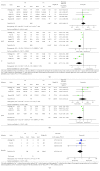Cost-Effectiveness of Cardiac Rehabilitation in Patients with Coronary Artery Disease: A Meta-Analysis
- PMID: 31275640
- PMCID: PMC6589196
- DOI: 10.1155/2019/1840894
Cost-Effectiveness of Cardiac Rehabilitation in Patients with Coronary Artery Disease: A Meta-Analysis
Abstract
Background: Medical costs associated with cardiovascular disease are increasing considerably worldwide; therefore, an efficacious, cost-effective therapy which allows the effective use of medical resources is vital. There have been few economic evaluations of cardiac rehabilitation (CR), especially meta-analyses of medical cost versus patient outcome.
Methods: The target population in this meta-analysis included convalescent and comprehensive CR patients with coronary artery disease (CAD), the status most commonly observed postmyocardial infarction (MI). Here, we evaluated medical costs, quality-adjusted life year (QALY), cost-effectiveness, mortality, and life year (LY). Regarding cost-effectiveness analysis, we analyzed medical costs per QALY, medical costs per LY, and the incremental cost-utility ratio (ICUR). We then examined the differences in effects for the 2 treatment arms (CR vs. usual care (UC)) using the risk ratio (RR) and standardized mean difference (SMD).
Results: We reviewed 59 studies and identified 5 studies that matched our selection criteria. In total, 122,485 patients were included in the analysis. Meta-analysis results revealed that the CR arm significantly improved QALY (SMD: -1.78; 95% confidence interval (CI): -2.69, -0.87) compared with UC. Although medical costs tended to be higher in the CR arm compared to the UC arm (SMD: 0.02; 95% CI: -0.08, 0.13), cost/QALY was significantly improved in the CR arm compared with the UC arm (SMD: -0.31; 95% CI: -0.53, -0.09). The ICURs for the studies (4 RCTs and 1 model analysis) were as follows: -48,327.6 USD/QALY; -5,193.8 USD/QALY (dominant, CR is cheaper and more effective than UC); and 4,048.0 USD/QALY, 17,209.4 USD/QALY, and 26,888.7 USD/QALY (<50,000 USD/QALY, CR is costlier but more effective than UC), respectively. Therefore, there were 2 dominant and 3 effective results.
Conclusions: While there are some limitations, primarily regarding data sources, our results suggest that CR is potentially cost-effective.
Figures




References
-
- Balady G. J., Williams M. A., Ades P. A., et al. Core components of cardiac rehabilitation/secondary prevention programs: 2007 update: a scientific statement from the american heart association exercise, cardiac rehabilitation, and prevention committee, the council on clinical cardiology; the councils on cardiovascular nursing, epidemiology and prevention, and nutrition, physical activity, and metabolism; and the american association of cardiovascular and pulmonary rehabilitation. Circulation. 2007;115(20):2675–2682. doi: 10.1161/circulationaha.106.180945. - DOI - PubMed
-
- Piepoli M. F., Corrà U., Benzer W., et al. Secondary prevention through cardiac rehabilitation: from knowledge to implementation. A position paper from the cardiac rehabilitation section of the European association of cardiovascular prevention and rehabilitation. European Journal of Cardiovascular Prevention & Rehabilitation. 2010;17(1):1–17. doi: 10.1097/hjr.0b013e3283313592. - DOI - PubMed
Publication types
LinkOut - more resources
Full Text Sources
Miscellaneous
